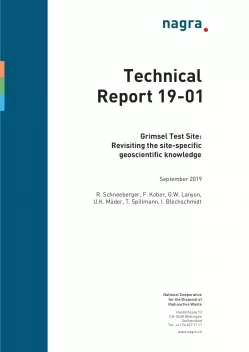
Technical Report NTB 19-01
Grimsel Test Site: Revisiting the site-specific geoscientific knowledge
The Grimsel Test Site was opened in June 1984. Since then it has been dedicated to fundamental research related to the safe disposal of radioactive waste in deep geological repositories. The research performed at the GTS has evolved with the requirements of the RD&D programmes of the numerous partner organisations carrying out experiments. In a first phase, experiments were dedicated to site characterisation techniques, resulting in a geological description of the rock volume surrounding the GTS. In a second phase, processes associated with radionuclide migra¬tion, excavation and two-phase flow were evaluated in various projects. The current investigation phase is dedicated to (a) long-term experiments and demonstration experiments aimed at the confirmation and validation of numerical models developed for the safety assessment of a typical repository and (b) the long-term evaluation and monitoring of processes such as corrosion of canister materials.
The geological description of the rock mass around the GTS has benefited from the geoscientific knowledge broadened by all the performed experiments. The work presented in this report revisits multiple experiments and aims to provide an overview of the acquired knowledge. It also compiles milestone publications to facilitate in-depth study.
The following points summarise the current state of knowledge:
- The rock mass surrounding the GTS is composed of Late to post-Variscan (ca. 299 Ma) granitoids (Central Aar Granite and Grimsel Granodiorite). Shortly after emplacement, the granitoids were dissected by numerous dykes, mainly metabasic dykes (formerly termed lamprophyres), but also aplitic dykes.
- During the Alpine orogeny (climax at ca. 25 Ma), the rock volume was metamorphosed under greenschist facies conditions and solid-state deformation initially in the ductile regime led to the development of a pervasive foliation and localised high-strain zones, so called ductile shear zones.
- Ongoing uplift and resulting cooling yielded a gradual shift from deformation in the ductile regime to deformation in the brittle regime. The retrograde brittle overprint resulted in the formation of complex fault zones localised along former ductile shear zones or margins of metabasic dykes. The fault zones often display an anastomosing arrangement of fault cores that are characterised by the occurrence of fault gouge (fine-grained cohesion-less fault-filling material). The highly localised brittle deformation and the preceding ductile deformation yielded a heterogeneous rock mass with strongly deformed zones alternating with unfractured rock matrix.
- The heterogeneity of the rock volume is of central interest and has significant implications for numerous investigations such as characterisation of the stress state. The fault zones at the site decouple individual crustal blocks, resulting in varying stress conditions depending on the distance to the fault zones.
- The heterogeneity is also observed in the hydraulic characterisation of the rock volume, where intervals within major water-conducting fault zones are characterised by transmissivity values ranging over 5 orders of magnitude, while borehole intervals in unfractured rock matrix show typically low hydraulic conductivities of 10-11 m/s or below.
- Linked to the evolution of the water flow paths is the composition of the groundwater, which differs between fault water and rock matrix water. The fault water composition depends on the mean residence time as the original meteoric water is enriched by water-rock interactions.
- The careful characterisation of baseline conditions allowed the identification and cataloguing of numerous perturbations, both natural and anthropogenic. Identified perturbations include earth tides, annual air pressure changes, nearby lake level changes, experimental work such as hydraulic testing or drilling or tunnel ventilation.
The multiple aspects of the research summarised here are discussed in detail in numerous project reports. These projects and their major outcomes are introduced and summarised in the last chapter of this report. The detailed investigations performed during the last three decades provide a robust basis for future experiments, which can be planned based on the experience and knowledge gained over the last 35 years.
Magasin
| version papier, anglais | CHF 20,00 |

